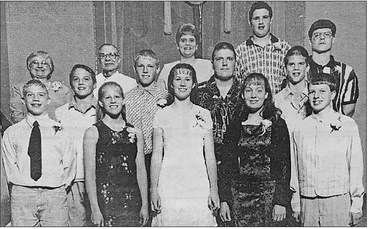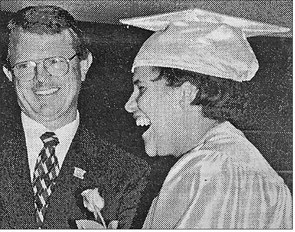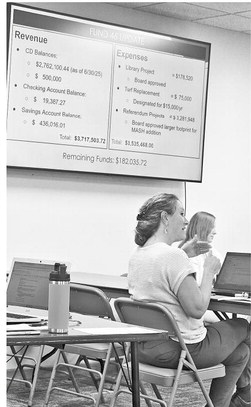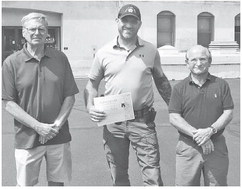PAGING THROUGH HISTORY:


STRATFORD JOURNAL
50 YEARS AGO...
WEDNESDAY, MAY 21, 1975
Top Students
Valedictorian of the 1975 graduating class of Stratford High School is Katherine Weber, daughter of Mr. and Mrs. Arnold Weber. Salutatorian of the 1975 class is Kathy Lasilla, daughter of Mr. and Mrs. Waino Lassila. Class colors are green and white. The motto is “The past is forever gone, the future still our own.”
Tigers Place in Track Meet
At the Marawood conference track meet held at Edgar, the Stratford boys place sixth out of nine schools participating. Stratford’s only conference champion was Jim Zuelke, who took first in the 880-yard run.
The Stratford’s girls’ track team placed 8th in the Marawood conference track meet held at Athens. Both teams will be competing in the regional track meet at Edgar.
Tiger Baseball Team Ties Nekoosa
Stratford closed out its Marawood conference schedule with an impressive 11-0 shutout over Auburndale. Stratford tied Nekoosa for the conference with identical 8 and 1 records. Previous conference championships occurred in the fall of 1954, fall of 1958, spring of 1959, and spring of 1963.
25 YEARS AGO...
WEDNESDAY, MAY 24, 2000
Area artists to exhibit at state fair
Sixteen Stratford High School students will have a total of 21 pieces of artwork displayed at the 2000 Young People’s Art Exhibit at the Wisconsin State Fair in West Allis, from August 3-13. Students are Nichole Frank, Heidi Stockheimer, Amanda Serwe, Nicole Williams, Justin Poeschel, Mari Lang, Kristen Koontz, Charlene Heil, Laura Mews, Ben Reinwand, Jed Hannemann, Jessica Bohman, Cheryl Kaiser, Mandy Skwierczynski, Candi Leick, and Megan Schillinger.
Rockets make plans
The Rozellville Rockets met in May at the Pioneer Bank, Rozellville. Club president Tammy Wyman presided over the meeting.
RECORD REVIEW
50 YEARS AGO...
THURSDAY, MAY 22, 1975
98 to graduate at Marathon
Commencement exercises for 98 Marathon High School seniors will be held tonight at 8 p.m. in the high school auditorium. Joe Blume, senior class president, will be the master of ceremonies and will deliver the welcoming address.
Badger Staters
Four Athens High School students have been chosen to represent their school at Badger Boy and Girl State conventions this summer. Lori Giese will be the Badger Girl with Sherri Nehrbass as alternate. Steve Braun was chosen as Badger Boy with Rus Schneveis as his alternate.
Edgar girls continue track dominance
Sue Johnson was voted the most valuable girl athlete at the Edgar Invitational. Johnson won three individual events and also ran the anchor leg of the winning Edgar mile relay team. Edgar won the meet with 127 points.
25 YEARS AGO...
WEDNESDAY, MAY 24, 2000
Van Der Geest public hearing
Monday’s DNR hearing allowed public testimony before they will consider issuing Van Der Geest Dairy Cattle, Inc a permit to land apply waste from up to 3,000 cows on 3,774 acres of cropland. The farm located in the Town of Maine is currently the biggest dairy in the state.
New Athens clinic construction set
A new 5,000 square foot medical center for the Village of Athens is set for construction in September, according to a spokesman from the Marshfield Clinic. Ellenbecker Properties, LLC will own the new brick-faced clinic and lease it to Marshfield Clinic.
Edgar officers
Edgar High School has announced senior class officers for the 2000-01 school year. Senior class representatives are president Jessica LeBlanc, vice president Becky Mueller, secretary Melissa King, treasurer Candice Kaiser, and Student Council Carmen Borchardt and Elizabeth Hack.
2000 – St. Joseph’s graduation
St. Joseph’s Catholic School, Stratford, graduated eleven students at a candlelight Mass. The graduates are Adam Knoll, Heather Bohman, Makayla Crownhart, Holly Spindler, Michael Spindler, David Rock, Matthew Bohman, Thaddeus Kunkel, Kyle Leonhardt, Chase Linzmeier and Lance Erwin. THE RECORD-REVIEW ARCHIVES
2000 – Congratulations
Edgar High School principal Mark Lacke shares a joyous moment with senior Jackie Garton during their graduation ceremony.
THE RECORD REVIEW ARCHIVES




